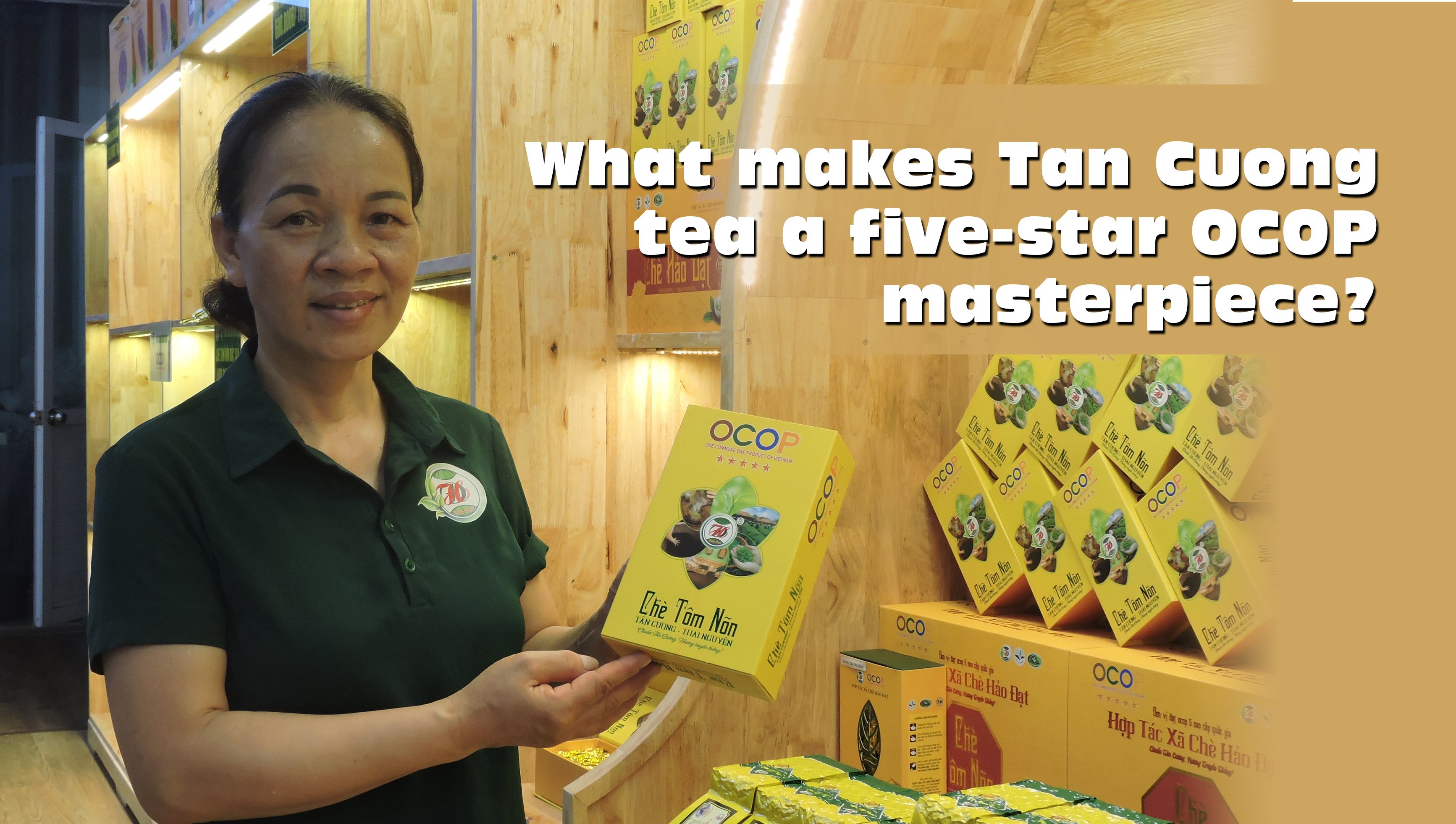Hao Dat Tea Cooperative is the most famous brand in Tan Cuong, not only thanks to it being the first tea brand to receive the five-star OCOP endowment but also carrying on the Pham family’s legacy.

Along the road from Thai Nguyen City to Tan Cuong commune, yellow-green panels stand out on the gentle midland tea hill. Hao Dat Tea Cooperative offers travelers a rest stop to enjoy free tea. Hao Dat Cooperative takes pride in the national endowment of a five-star OCOP product. Tan Cuong Tea Culture Space is a tourist attraction of Tan Cuong Tea Cooperative Union. Our colleague in Thai Nguyen said that in recent years, visitors who came to Tan Cuong –whether intentionally or just wandering by – could stop to enjoy a delicious teapot and brittle green tea. All are free. Such a unique culture has its root in the land of tea, from pioneer workers and cooperatives.
In a Tay-style wooden stilt house at the entrance of Tan Cuong commune, Ms. Dao Thanh Hao, Director of Hao Dat Tea Cooperative meticulously brewed a teapot to invite guests. That is the “Non Tom” tea (harvested with bud and young leaf ratio of 1:1) – the first five-star OCOP product of Thai Nguyen province endowed in June 2021.
The brewed tea has fresh green water and a sweet aroma. Already in the early summer morning, the city is hot, but as soon as we arrive at the commune, we feel a change of breeze. The place is noticeably cool and comfortable. Eating a brittle piece, sipping a tea cup – bliss.
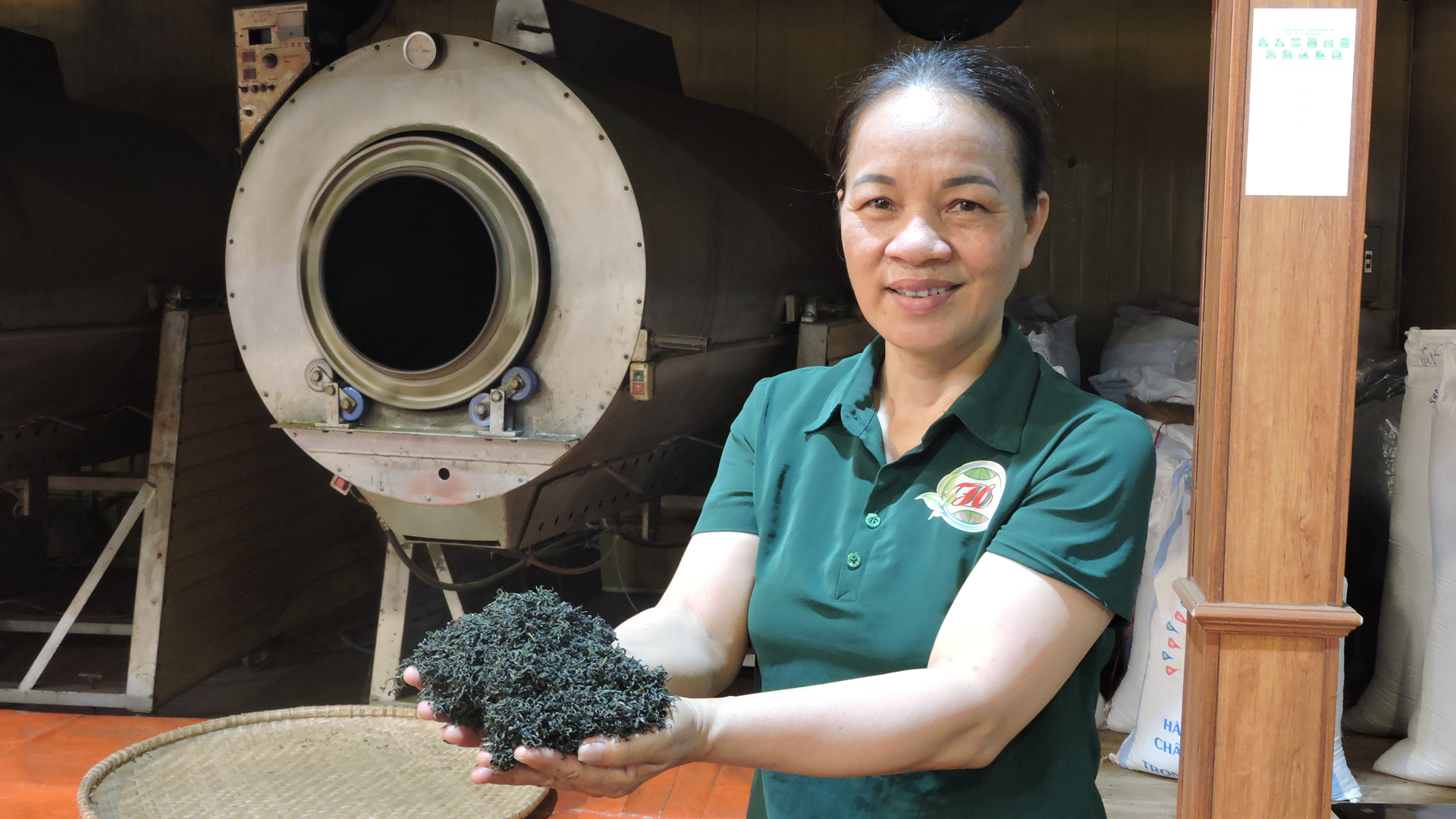
On rare occasions when guests come by,
Heat some coal, steam some water, brew some hot tea to serve,
Oh, this tea is so precious,
One cup for each person to cheer up the brewer.
Someone hums an anecdote about the most famous tea cooperative in Tan Cuong, magnifying endlessly in the refreshing air.
“My ancestors were one of the wealthiest landowners in Tan Cuong.” Pouring another tea round for guests, Mr. Pham Tien Dat, Mrs. Hao’s husband, contemplatively reminisced. “There used to be a time when nearly half of Tan Cuong tea area was owned by librarian Pham Van Hoc, my grandfather. According to a generational story, in 1928, members of the Pham family traveled from Vu Ban, Nam Dinh to settle here. Thanks to their diligence, hard labor and adaptation rooted in the virtue of lowland folks, they gradually developed a vast land, associated with the local tradition of tea. They became the richest, most prominent and most famous tea brand in the region. Tan Cuong tea of the Pham family became well-known. There used to be a time when the house accommodated dozens of merchants.”
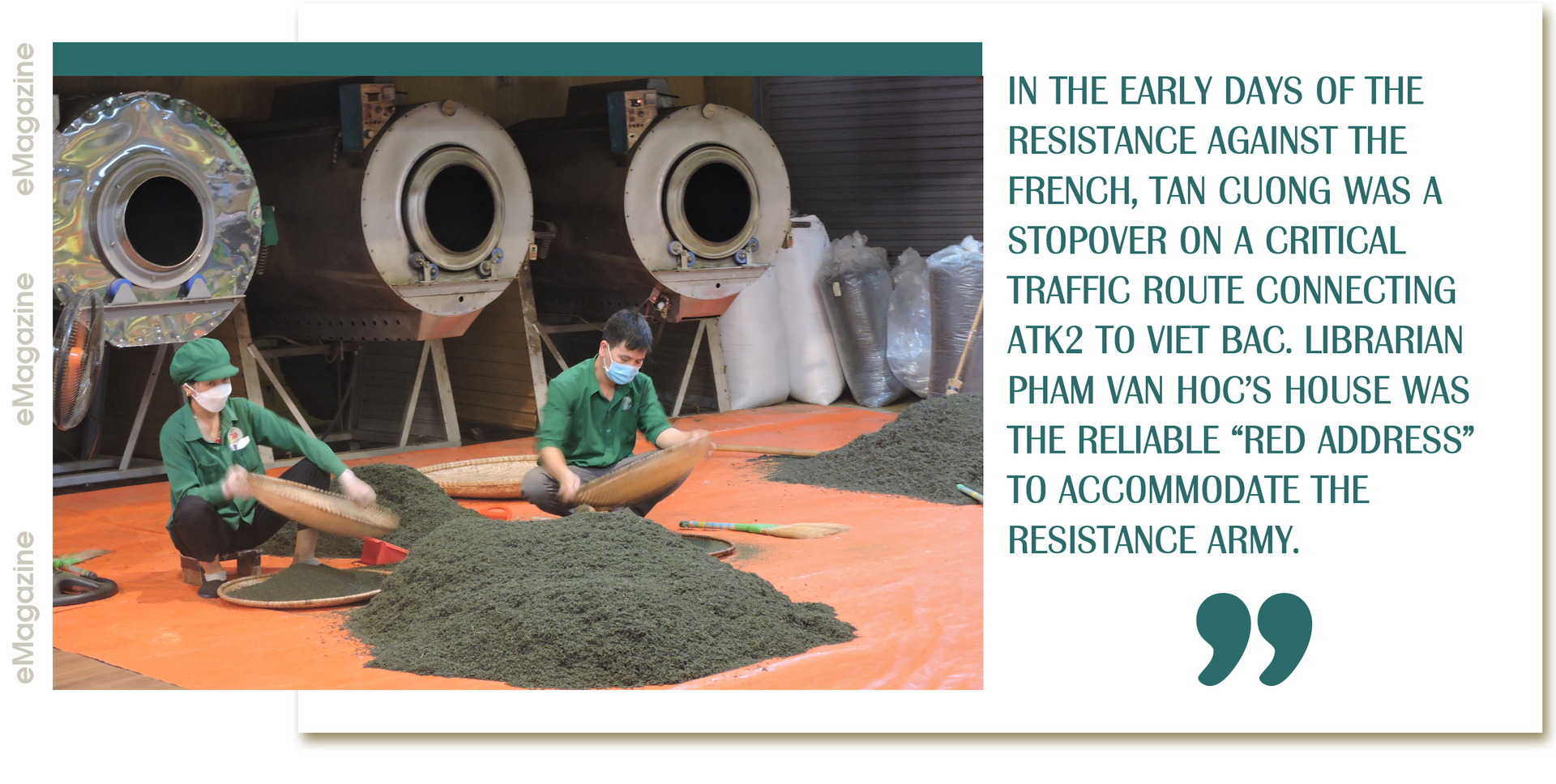

As a generous person with a firm belief in the revolution, the old gentlemen largely supplied his goods and helped to hide cadres. Certificates and awards for librarian Pham Van Hoc’s contribution are still kept in the Pham ancestral house in Tan Cuong. Unfortunately, that grandeur and abundance died out during the land reform period. Despite his contributions to the revolution, Mr. Pham Van Hoc was not excluded from that era’s circumstances. His agricultural land, houses and all property were redistributed to landless people and migrants seeking new economic opportunities.
Each descendant of the Pham family retained only a few thousand square meters of land to grow tea, similar to many other families. By the time of the cooperative economy, many descendants had left their hometown, while the rest clinged to the crumbling tea industry. Formerly a soldier, Mr. Dat came back home before Doi Moi (reformation in 1986). Agricultural land was vast but the economy was stagnant, so Tan Cuong people were mostly impoverished. Mr. Dat’s aspiration to restore the traditional tea profession seemed daunting, until he started a family with Ms. Hao from the neighboring Y Na tea village. On the first day in the Pham family, the Y Na bridetold her husband that, if he wanted to bring the Tan Cuong tea brand to the world, the couple alone could not do it. They had to reach out to go far together.
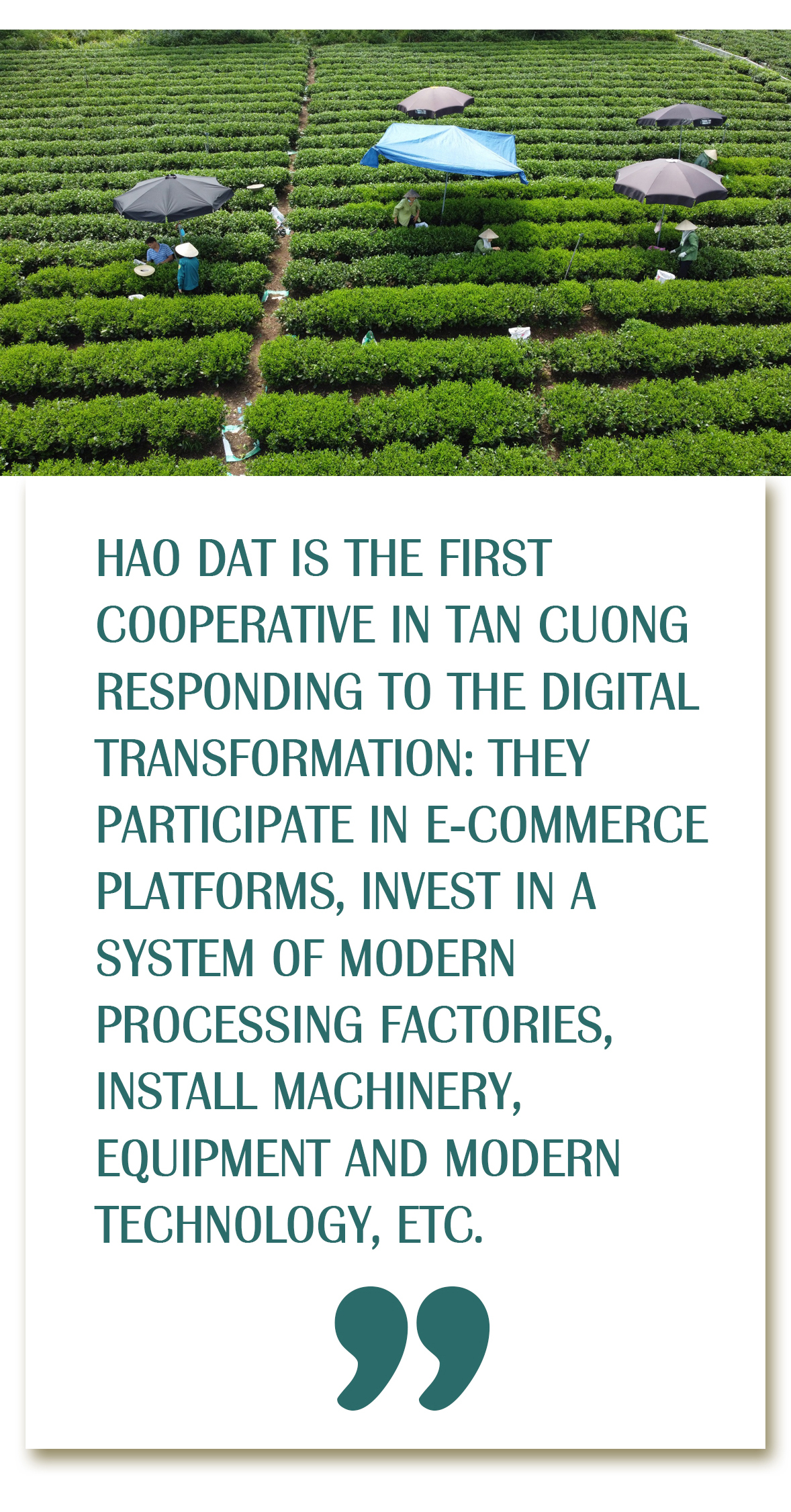
The collective then the cooperative were established. Initially there were only 7 households and agricultural land only enclosed a few scattered tea gardens. But after only a few years, Hao Dat became the largest cooperative in Tan Cuong tea area: more than 50 official members, hundreds of associated households; nearly thousands of tons of specialty tea sold each year, revenue of tens of billions VND; science, technology and digitization are applied to the joint area and production processes. It is all inspired by Mrs. Dao Thanh Hao, the woman born in 1964. Indeed, many people make a fun comparison between her role in developing Tan Cuong tea and Mr. Dang Le Nguyen Vu who advanced Central Highlands coffee. Of course, all comparisons are indefinite, but what Ms. Hao has done in the finest tea district is fascinating.
Guiding us through the picturesque tea hills, Mrs. Hao genuinely says everything now seems like a dream. In the past, mobilizing people to join the cooperative was with the desire to properly rebuild the traditional Tan Cuong tea brand. And perhaps, it was that proper direction leading to the Hao Dat chain today. 60% of Tan Cuong tea goes to the market through cooperatives. Private and joint plots are subjected to digitization, from raw material to processing; all complying with VietGAP standards to make organic or organic-oriented products. Cooperative members clock in and out using the timekeeper, and payment is push-to-card.

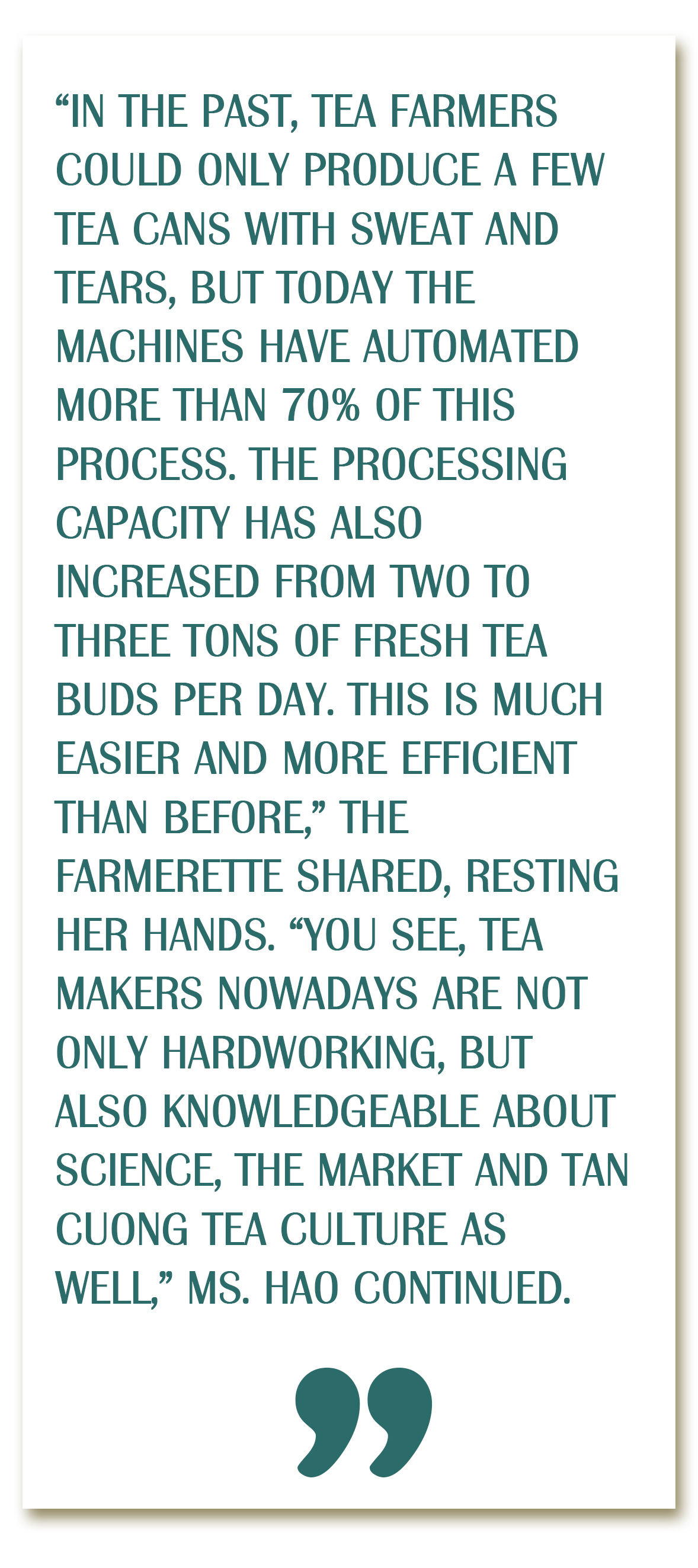
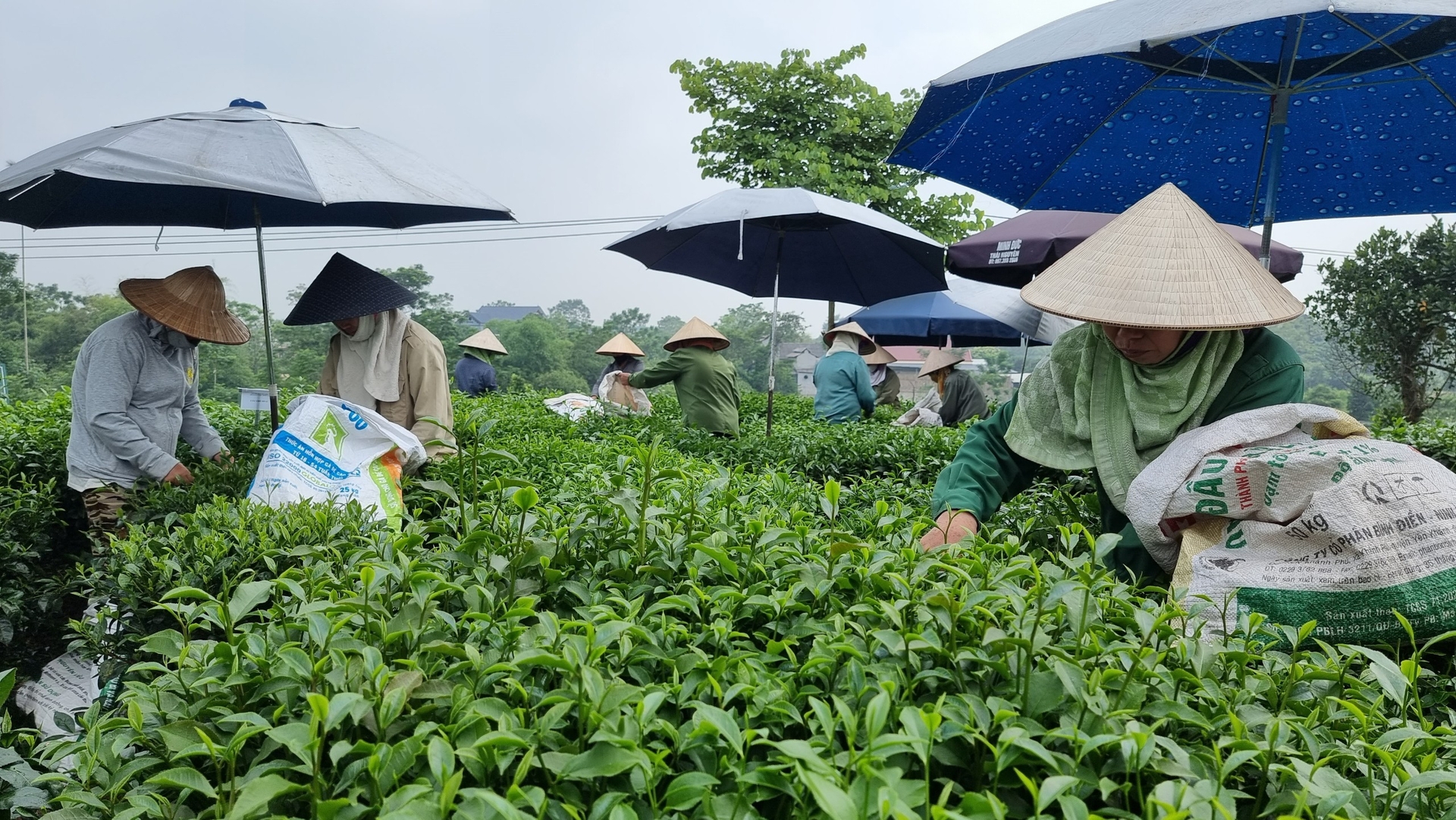

Earlier this year, Hao Dat Tea Cooperative honorably welcomed a special guest. During his work trip to Thai Nguyen province, General Secretary Nguyen Phu Trong visited the Tan Cuong tea district, primarily in Hao Dat cooperative. It was the honor that Mrs. Dao Thanh Hai said was “the happiest in her lifelong pursuit of tea trees.”
“You see,” she said proudly, “workers in agriculture are used to hard labor and lower investment than other professions, so we were delighted to welcome the General Secretary. The event marked the Party and national leaders’ interest in agriculture, farmers and rural areas, affirming that our agricultural products are improving everyday. What could be happier then standing on a tea hill with the General Secretary, sharing with him about our livelihood, and seeing him personally pick a fresh tea bud then taste it – skillfully as though he was a native in this tea district. No advertisement could surpass that image, the tea farmers were extremely encouraged and proud. After years of changing mindset and improving product quality, now the tea farmers will continue to change to be worthier of that affirmation.”
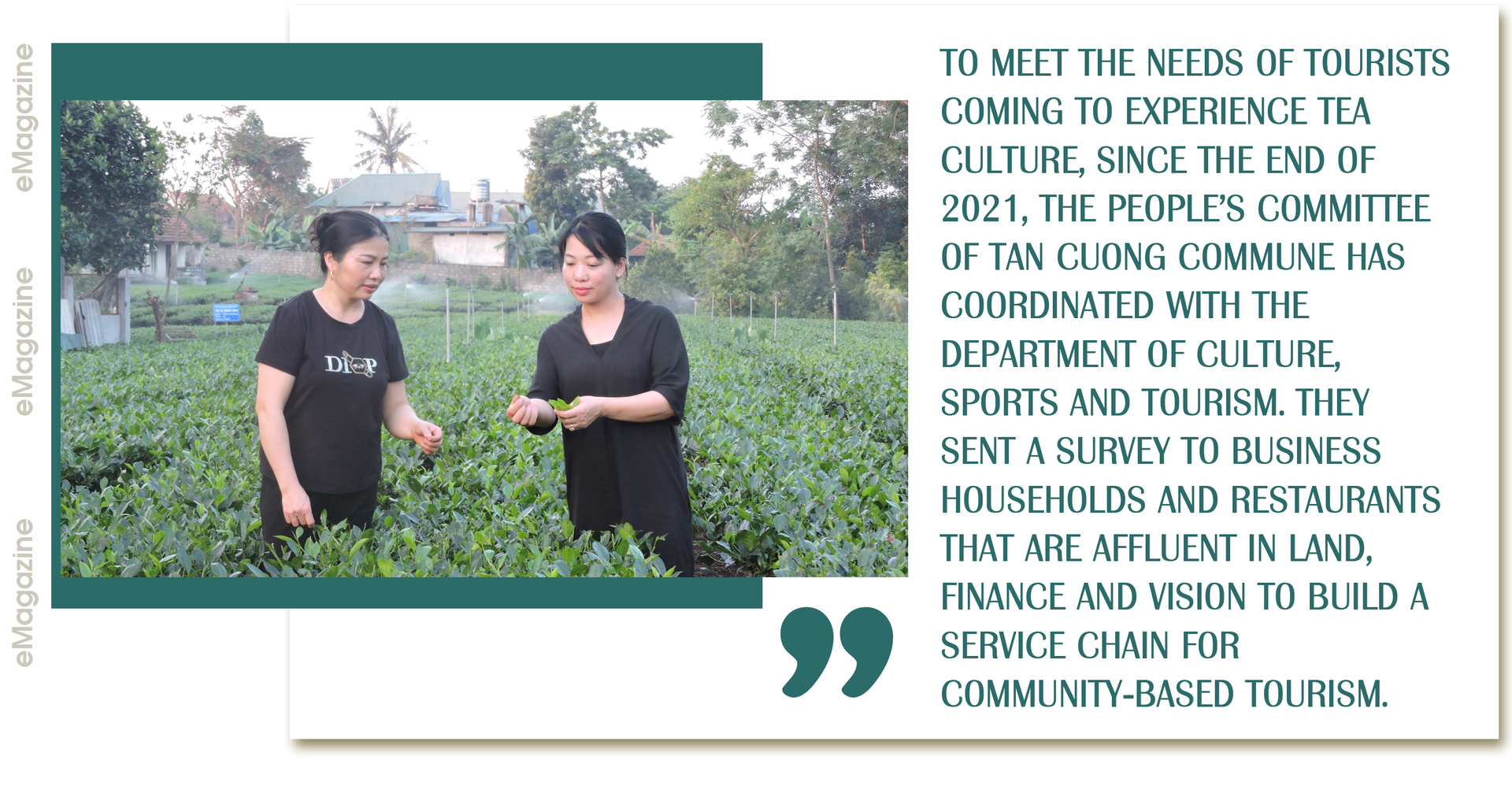
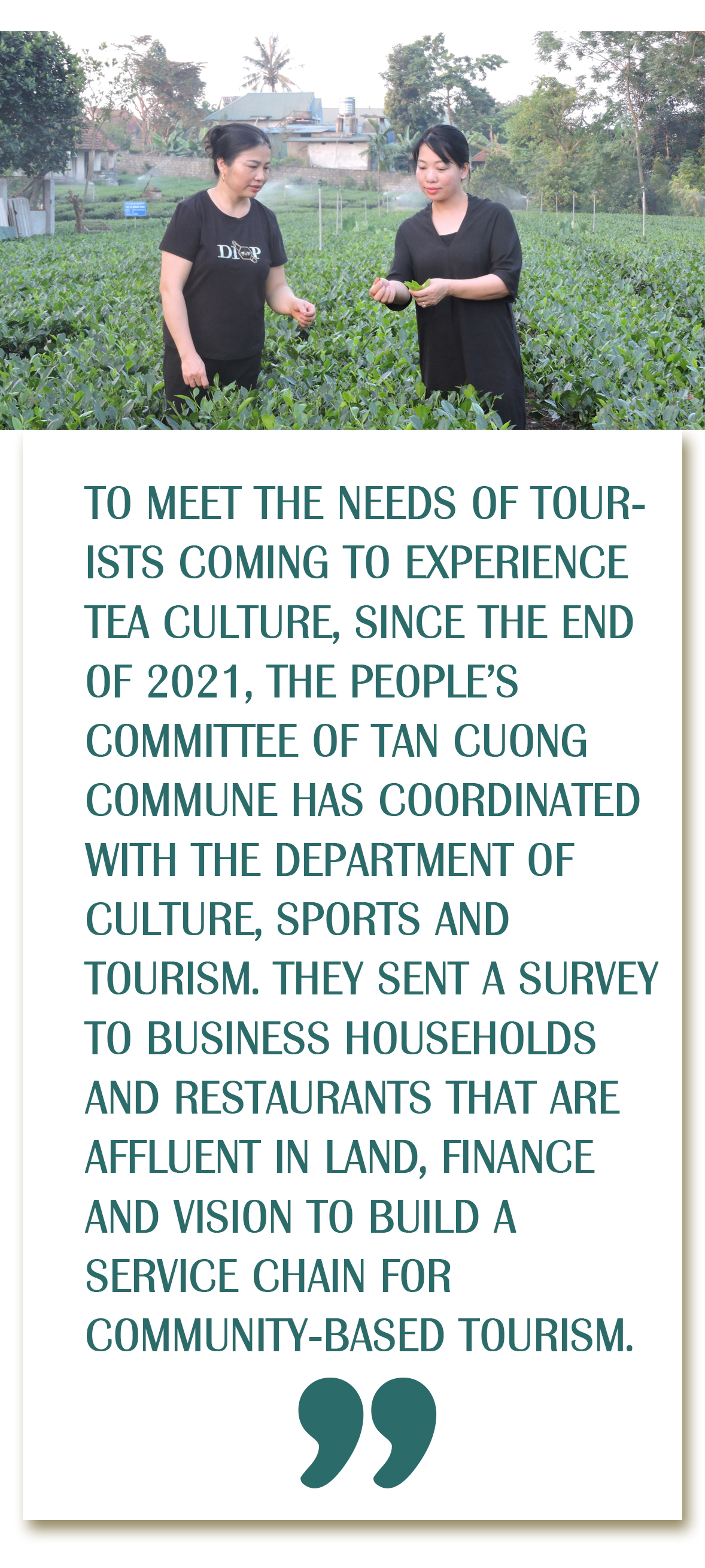
In the past, the finest tea district witnessed a situation in which farmworkers used a lot of fertilizers and chemical plant protection drugs. It resulted in poor tea quality, land degradation which could only grow tea and nothing else. This valuable lesson led to mindset changing; people switched to organic tea making and began to restore the ecosystem. Besides tea, people can now grow fruit trees and shade trees.
Lies at the foot of the hill, along the stream, are additional rice plots, fish farms, or lotus ponds. Tan Cuong is now a beautiful demonstration of agricultural cultivation, ranking no less than famous eco-tourism areas. Tea farmers are also establishing agricultural tourism services such as photobooths on tea hills, homestays, experiential tea making for tourists, etc.
“We must continue to change, to not only promote tea products but also cultural values and Tan Cuong landscapes, integrating multi-values as the agricultural industry has proclaimed,” said Director of the most famous Tan Cuong tea cooperative.
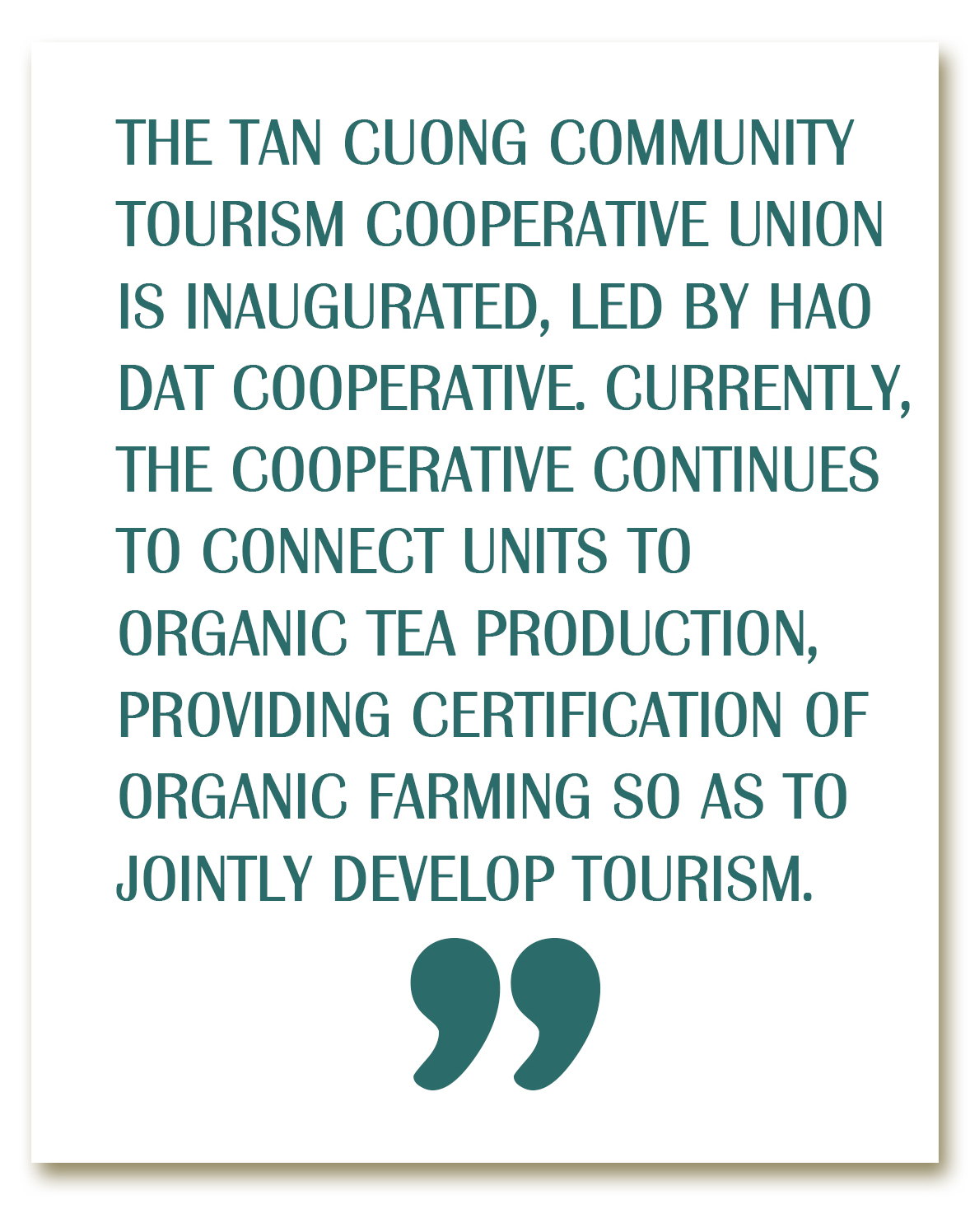
With great determination, at the end of last year, Hao Dat Tea Cooperative collaborated with three tea cooperatives to establish the Tan Cuong Community Tourism Cooperative Union. They also built a tea culture space, enclosing a tea garden, community house, and specific areas for processing, handicraft, packaging, tea tasting, and product displaying. They aim to create a space so that visitors can feel the graciousness of Tan Cuong land, tea and people. Tourists can drink a cup of tea, enjoy side dishes and listen to stories about Tan Cuong land and people to connect more deeply with this place.
“I always wonder how the Chinese can make such high value teas. Is it because they know how to breathe life into their products? Why hasn't Tan Cuong done it? Therefore, in our tea culture space, Tan Cuong artisans serve the finest tea to the guests and tell stories about our land, people and tea industry. The guests can also make products or experience all stages of tea and processing by themselves. Only with this direction can we further improve the value of Tan Cuong tea,” said Ms. Hao.

In 2022, Thai Nguyen province recognized Tan Cuong as a community-based tourism destination, besides Mo Ga village, Phu Thuong commune, Vo Nhai district. Chairman of the Tan Cuong Community Tourism Cooperative Union acknowledges the land’s latent potentials and advantages in terms of resources and indigenous culture, awaiting to be uncovered.
Tea culture is especially energetic. Among more than 170 OCOP products rated from three to five stars in Thai Nguyen province, tea making accounts for more than 121 products. The expertise to cultivate and process Tan Cuong tea is also recognized as the nation’s intangible heritage.Such great values need to be realized for community-based tourism in association with sustainable agricultural development, green production, farm-to-market value chain, thereby creating both tourism products and farmers’ well-being.
This 2023 tourism year, Thai Nguyen province promotes their cultural richness with the theme “Experiencing the land of tea.” They aspire to attract the market to the production area, the finest tea district.
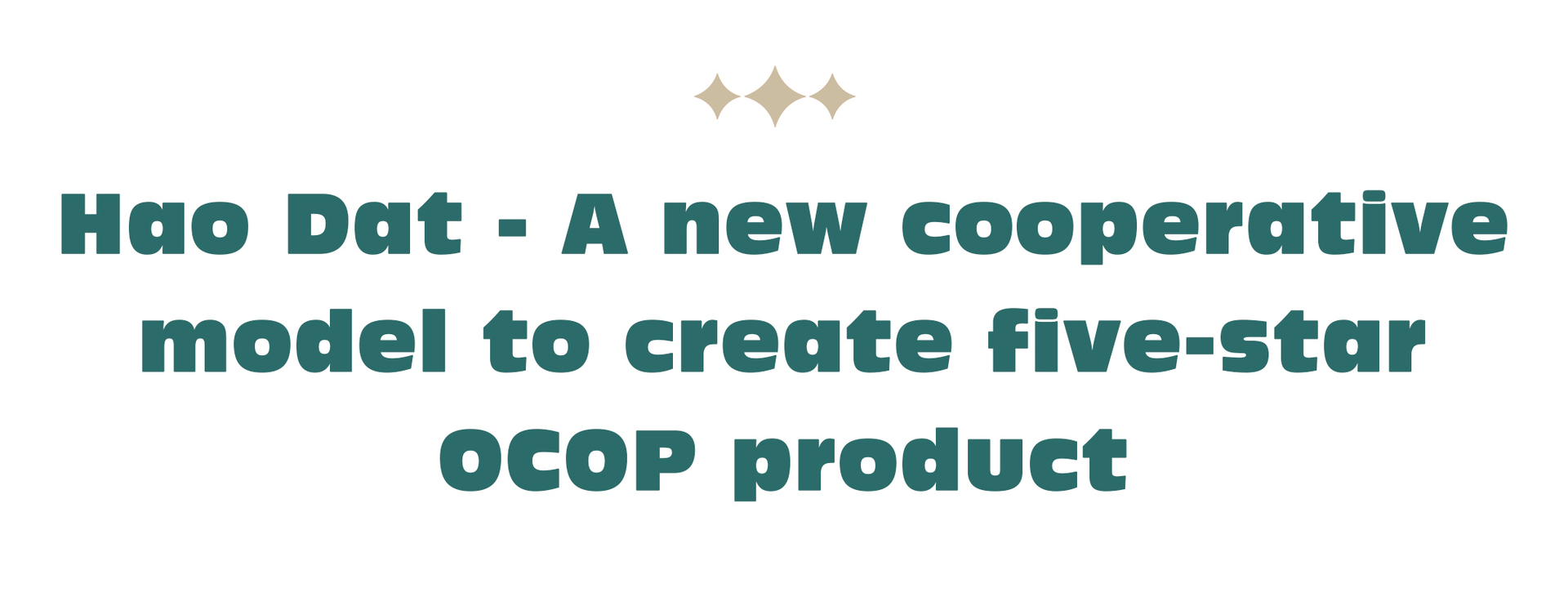
From a cooperative with three production cooperative members in 2012, Hao Dat Tea Cooperative expanded and officially was established in December 2016. At first, the cooperative had only seven members, six hectares for tea cultivation and a charter capital of 300 million VND. Currently, the cooperative has 30 official members and nearly 100 associated households; their charter capital has reached 30 billion VND. Those are impressive numbers, confirming the appropriate development of Tan Cuong tea over the years.
To ensure a uniform and stable quality across the seasons, Hao Dat Cooperative has a technical consulting department on tea growing, harvesting and processing. Households in the area, when signing contracts with cooperatives, are supported with money to buy seedlings, fertilizers, etc. without interest. Thanks to that, farmers have safe fresh bud tea products, thereby improving the quality of the cooperative's products.
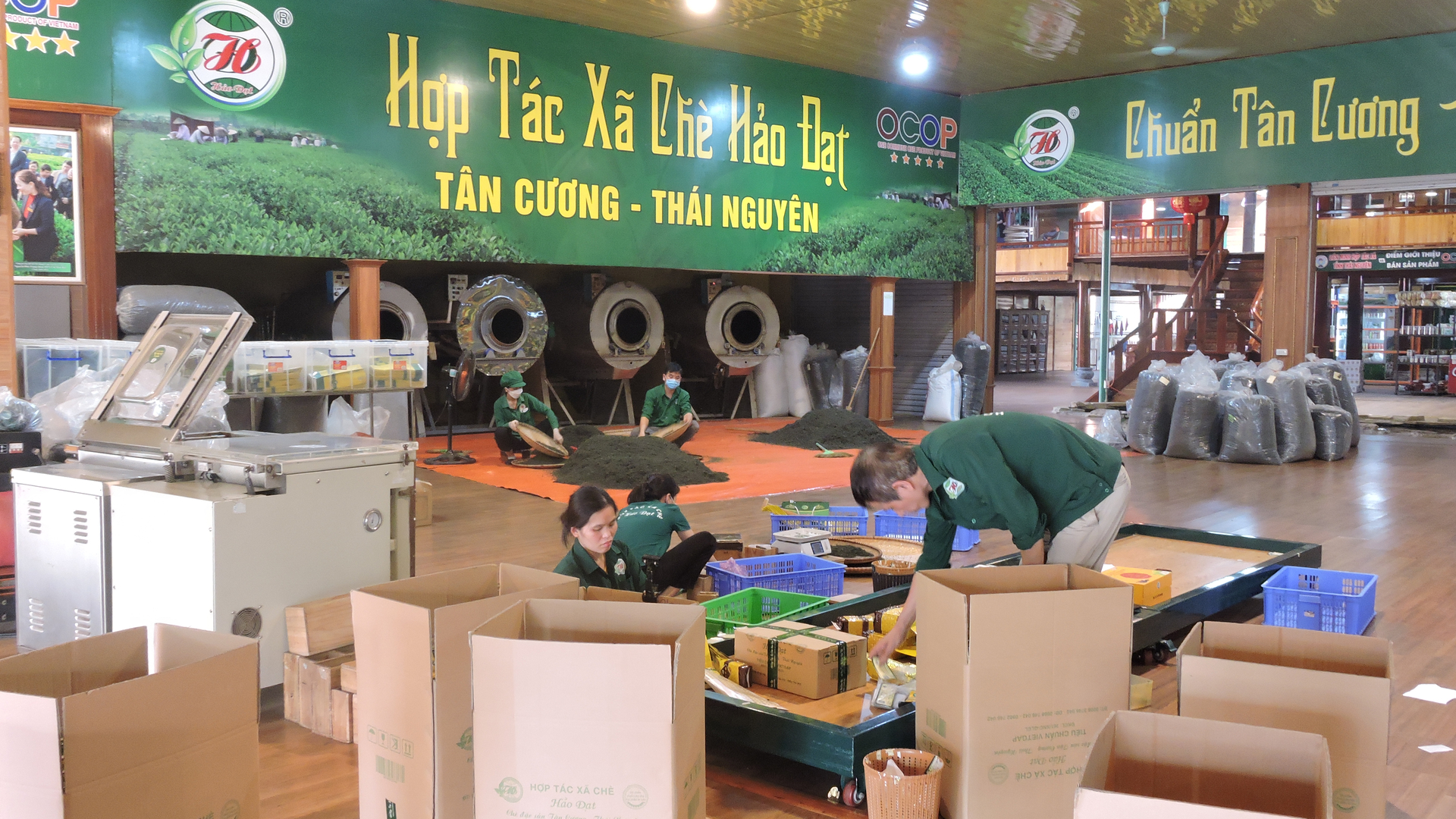
Hao Dat Tea Cooperative pays special attention to scientific and technological application, clean production processes, using clean water sources and not harmful chemicals, thereby meeting VietGAP standards. Affiliated household members that supply fresh tea buds to Hao Dat must know how to cultivate and process tea according to safety standards. Only with those requirements can the Hao Dat tea brand develop, guaranteeing delicious tea products that are competitive in the market.
Director of Hao Dat Tea Cooperative, Mrs. Dao Thanh Hao discusses the enigma of Tan Cuong tea. Valuable products such as the “Dinh” tea and “Tom Non” teas are rooted in a strict harvesting process. This process is dependent on the weather: one shall not pick the buds if it rains; or in the summer, harvest will stop after nine o’clock. All is to ensure that the tea buds gain the nutrition and sweetness of morning dew. That also contributes to the national five-star OCOP product of Hao Dat tea today.
In addition, in order to achieve the five-star OCOP endowment, Hao Dat Tea Cooperative always prioritizes traditional flavors. Over the years, Mrs. Hao has directly guided the production and taught everyone traditional tea making. The cooperative members have to put effort in cultivating, processing and packaging. Automation is applied to stages such as tea crumbling and drying, which advance the production capacity to 3 tons/day.
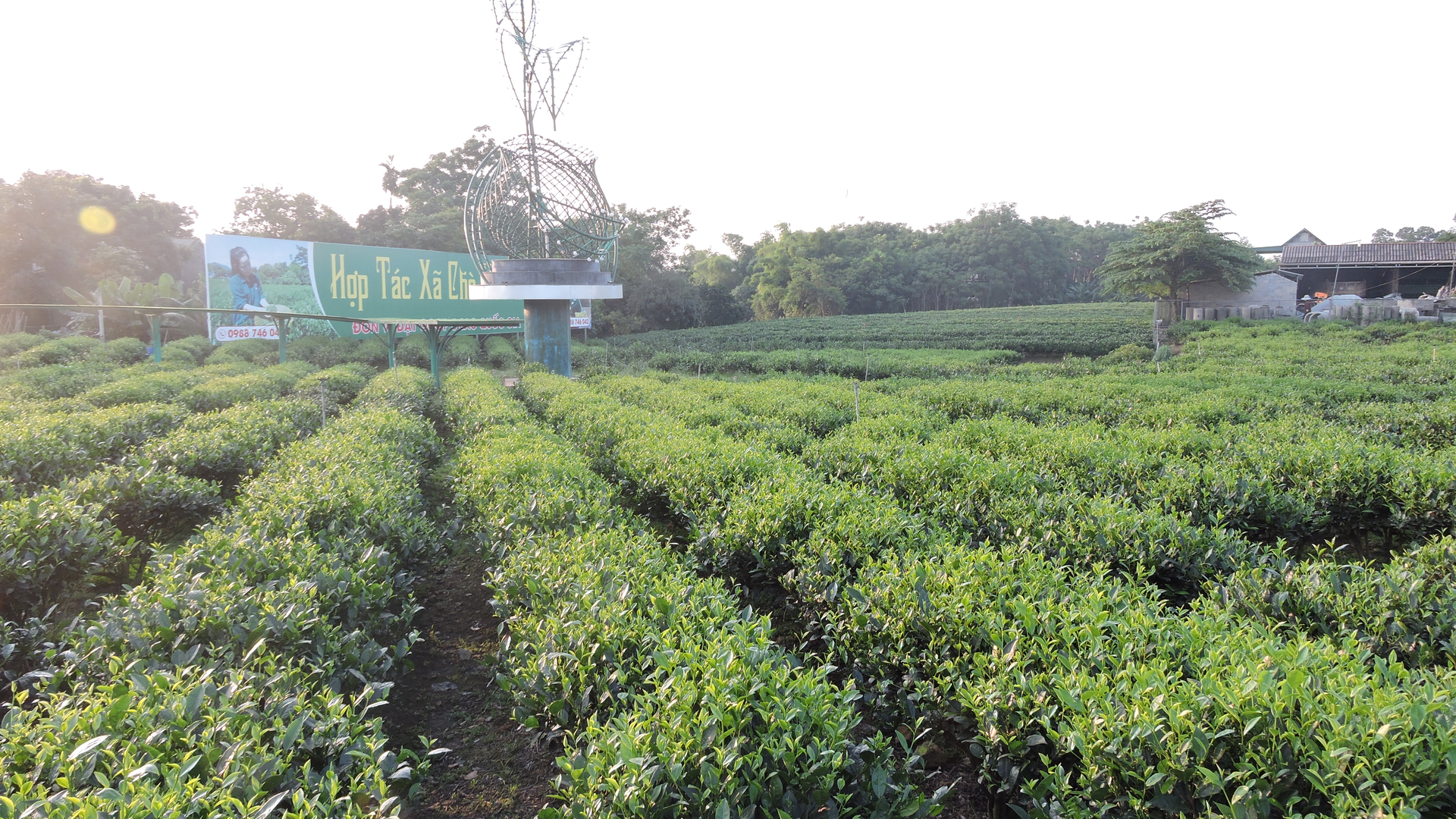
Authors: Toan Nguyen - Hoang Anh - Van Viet
Photo: Toan Nguyen - Van Viet
Translated by Quynh Chi
Designed by VAN


